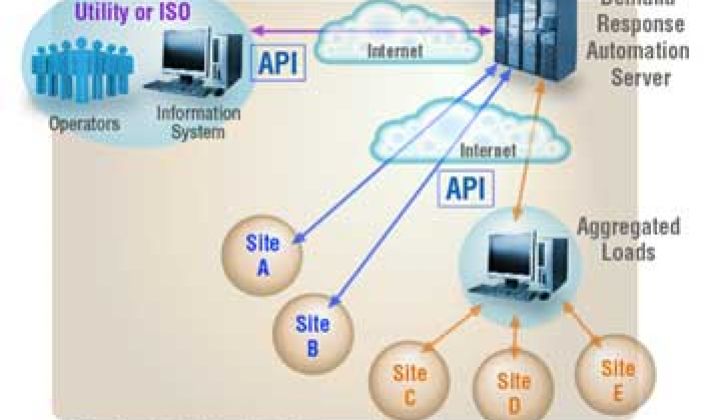It’s official: California’s big three utilities are getting behind OpenADR 2.0, the latest version of an open standard for turning buildings, motors, microgrids and other distributed forms of “demand” into grid assets. Starting next year, Pacific Gas & Electric, Southern California Edison and San Diego Gas & Electric will ask their partners to support OpenADR 2.0-certified products and platforms for locational dispatch of both emergency and price-based programs.
That’s according to a Monday announcement from the OpenADR Alliance, an industry group that includes energy services heavyweights like Honeywell, EnerNOC and Schneider Electric, along with a host of startups and specialist technology providers working on the next generation of automated demand response.
OpenADR comes from a Berkeley National Laboratory and California Energy Commission-sponsored project to create a simple, common, open protocol for communicating utility messages to its customers. Early partners included demand response automation server (DRAS) maker Akuacom, which was bought by Honeywell in 2010, and software developer and architect UISOL, which was bought by Alstom last year.
Since then, we’ve seen a host of technology vendors jump into the standard, including Schneider Electric and IPKeys, and new Silicon Valley smart grid big data startup AutoGrid, which got its technology OpenADR 2.0-certified last month. Big demand response provider EnerNOC uses OpenADR 1.0 in deployments with various technology partners such as Powerit Solutions, as well as via acquired companies like Global Energy Partners and M2M Communications.
In the meantime, we’ve seen a host of Japanese companies join the OpenADR 2.0 fray, including Hitachi, Toshiba, Mitsubishi, NTT and Fujitsu, which just showed off its 2.0-compliant demand response server at the Grid-Interop 2012 event this week in Irving, Texas. All the while, Honeywell and Akuacom, which still dominate the market, have launched OpenADR-based projects in other parts of the U.S., in China and in the U.K., as well as with unnamed partners in Europe.
California’s big three utilities already manage about 260 megawatts of demand response via OpenADR 1.0, making it the biggest market for the technology. But OpenADR 1.0 has always had its limits -- a fact that has led much of the industry to pause and await the release of the 2.0 version, according to industry experts.
For example, beyond setting power prices and general “low-medium-high” type energy reduction alerts, OpenADR 1.0 contained little ability to take each individual customers’ power profile and dispatchable load into account. Indeed, once a utility’s OpenADR 1.0 signal got to the building, it’s up to the technology behind the meter, so to speak, to translate those commands or price signals into action, and then to verify that something had been done.
OpenADR 2.0 is meant to provide a much more fine-tuned level of communication between utility and end user. The OpenADR Alliance, an industry group including most of the above-named companies, released a 2.0a specification in April.
It’s important to note, however, that the industry is still waiting for OpenADR 2.0b -- a version that includes some of the most critical capabilities, including fast-response times of within 4 seconds, all running over the internet. That last feature will be critical for enlisting buildings in automatically adjusting power usage to balance grid instability, or helping to mitigate the intermittent nature of wind and solar power -- the latter a big issue for California as it seeks to reach 33 percent renewables by the end of the decade.
Finally, it’s important to differentiate the OpenADR standard’s development to another important standard in utility-to-customer energy management. That’s Smart Energy Profile 2.0, the technology developed by the low-power wireless ZigBee Alliance that also supports Wi-Fi and the data-over-powerline HomePlug standard.
The key difference between the two standards is that, while SE 2.0 is meant to contain all the instructions to command individual devices to take power-saving actions, OpenADR is more of a communications standard to get messages from utilities to their customers.



